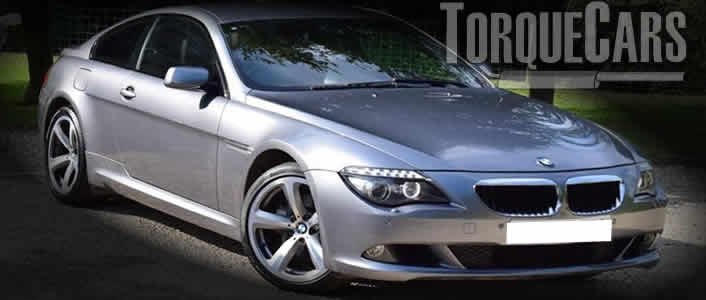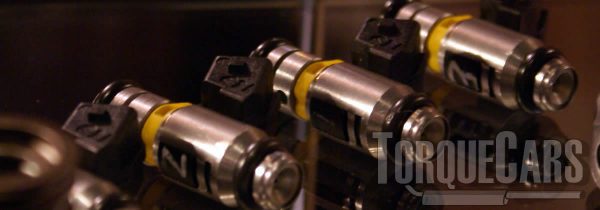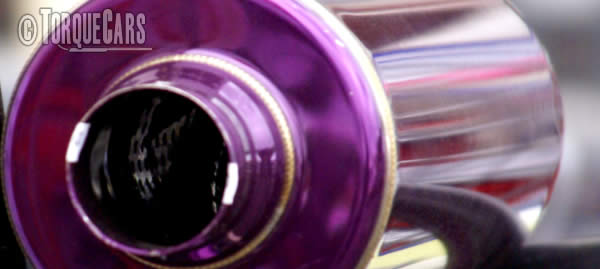Tuning the BMW 6 series
"Tuning guide to the greatest BMW 6 series modifications."
The 6 series is a great car modification project to have.
Think carefully and research 6 series tuning to avoid making the usual disastrous errors we often get told about.
Herein we review and look at 6 series tuning and point out the greatest modifications. BMW 6 series offer good returns when tuned and with carefully chosen tuning parts like a remap, turbo improvements and camshafts you will positively enhance your driving experience.

Handling/Suspension upgrades
Handling modifications are a good place to start for the 6 series.
Good suspension tweaks that radically improve handling for the 6 series include a couple of degrees negative camber and 1-1.5 degrees of toe (set out to improve cornering or in for better stability) on the front wheels.
We suggest that you fit uprated suspension and lower the car by 25mm - 36 mm. Larger drops require arch work - especially on models already equipped with uprated suspension.
Putting better brake discs and better brake pads should make for dramatically improved stopping.
Bear in mind that motorsport pads can be noisier and will need to be hot before they start to work.
On your regular commute to work the brakes are only used rarely so won't stop you as well so specify friction pads which have a low working temperature.
Turning our attention to the engine we need to get a bit more power out of the top end.
Sadly with smaller engine sizes you are wasting your time spending money on modifications, so if this applies to you get yourself an engine swap then apply the following mods.
Tuning modifications.
Typically these uprated kits are usually installed by our members, decide how far you want to push your car before you begin.

Getting the correct grade of modified upgrades for your planned usage of the car is a time and money saver. Stage 3 (competition) mods just won't work well on the road making the car difficult to drive.
Please watch our introduction Video tutorial to car tuning. Be sure to subscribe and support our new channel.
How to tune your car
- Improve the handling
Focus on Suspension improvements, such as coilovers and make sure the bushings are in good order and that the alignment is correct. Then focus on improving the brakes, with a big disk brake conversion kit and fast road brake pads.
- Remove restrictions
Focus on the intake and exhaust with filters being the common point of restriction in a tuned car. Intercoolers may also become restrictive on turbo engines so this may also need to be uprated.
- Burn more fuel & air
Increase the fuelling so it matches the air coming into the engine. The ratio is important so you need to improve the fuel pump and injectors, so the head mods, big valve conversions, fast road camshafts and forced induction upgrades extra supply of air is adequately met.
- Test and replace any weak parts
Weak areas are commonly the clutch, the turbocharger and pistons and crankshaft in a highly tuned engine. Makes sure these components will cope with your power aspirations.
- The Tune or Remap
A cars ECU controls the fuel, timing, spark and even the turbo in some cases, so to fully extract your gains you should remap the car last and this will fully release the power. Some cars are easy to map, and others require piggyback ECU's or aftermarket ECU's but this is the most vital step of your tuning project.
Modifying to Stage 1:
Alloy wheels, Panel air filter, Suspension upgrade (drop 25mm - 36 mm.), Remap, Sports exhaust, Lighter flywheel.
Modifying to Stage 2:
fuel pump upgrades, Fast road cam, Power/Sport clutch, high flow fuel injector, Ported and polished head.
Modifying to Stage 3:
Engine balancing, Adding or upgrading forced induction (turbo/supercharger), Competition cam, Internal engine upgrades (pistons/head/valves), Sports gearbox.
Your targets when tuning should be a flat and wide torque band. You don't want all the power to be at the top end of the rev range unless you are creating a motor sport car.
The whole point of our guides is to give a brief overview of car tuning modifications and point you in the right direction, our forum is best place to go if you need more detailed advice and tips on your modified car project, the best performance mods and all aspects of modding cars.Fast road cams offer one of the biggest torque gains for your money as far as a bolt on tuning modifications goes on a NASP engine.
The exhaust & intake valve durations play a large part in your cars power band, but be careful here, getting this wrong can upset the idle and make the car difficult to drive in traffic. You'd need to follow a camshaft upgrade with other mods and finish with a performance chip for the best performance gains.
Don't forget to increase the fuelling when you are increasing the power - it makes the car more thirsty.
If you find you get flat spots and surges after your uprated mods you should check the fuelling and try a higher octane fuel as well.  To get sufficient fuel you may need to upgrade the injectors on your engine.
To get sufficient fuel you may need to upgrade the injectors on your engine.
Uprate the fuel pump to cope with the extra fuel requirements of your tuned 6 series's uprated injectors.
Intake and Exhaust Tuning.
The next area for modification is the intake and exhaust.  Contrary to popular belief there is usually very little if any power gain achieved by fitting an induction kit, they only work well and are recommended after you raise the engines power to the point where the standard air intake box cannot cope!
Contrary to popular belief there is usually very little if any power gain achieved by fitting an induction kit, they only work well and are recommended after you raise the engines power to the point where the standard air intake box cannot cope!

Maximum power gains come from a full induction kit with a cold air feed on heavily tuned engines, this can be sited within an air box but a performance panel filter should suffice for most applications. TorqueCars suggest you use a panel air filter as these are easy to clean and maintain and generally perform better than paper ones.
Sports exhausts generally help improve air flow from the engine but avoid an exhaust that is too large or you may end up will reduce the flow rate. Stick to 1.5 to 2.5 inches for best results.
Getting the cylinder head gas flowed will assist in flowing more air into each cylinder. This is definitely a job for a pro with a flow bench. Your clutch can slip if it starts to break and the standard clutches are only ever good for power gains of up to 43%. Fit a power clutch to avoid power loss through the transmission. The best mods in our opinion for your 6 series are remaps, sports camshafts and induction improvements.
NASP engines do not achieve big power gains if you remap them, unless you have done extensive modifications. With turbocharged engines this is another story. A remapped turbo will give big power gains and take full advantage of the strength of the block. Adding forced induction will see impressive power gains but this is usually too expensive to be cost effective. Superchargers are usually easier to add than a turbo. With a turbo the power curve is related exponentially to the engine speed making it harder to map.
The nice correlating boost and rpm characteristics of the supercharger make them easier to map. Alternatively you could perhaps install water injection to reduce the risk of knock.
Alloy wheel upgrades.
Alloy wheels can help the brakes cool down and are generally lighter than steel ones. If you are serious about performance then you will need to carefully choose your tires - ideally with a directional tread pattern tire. We'd like to point out although they can look cool on the 6 series big alloys will actually decrease your performance. The larger you go the lower your acceleration will be - this to the change in your effective final drive ratio.
With this in mind we would advise sticking to a maximum wheel size of 18 inches, although we know some of our members have fitted larger wheels with no problems.
For more information on Tuning your car please join us in our friendly forum where you can discuss 6 series options in more detail with our 6 series owners. It would also be worth reading our unbiased BMW tuning articles to get a full grasp of the benefits and drawbacks of each modification.
Please help us improve these tips by sending us your feedback in the comments box below.
We love to hear what our visitors have got up to and which mods work best for them on each model of car. Comments are used to improve the accuracy of these articles which are continually updated.
If you liked this page please share it with your friends, drop a link to it in your favourite forum or use the bookmarking options to save it to your social media profile.
Check out TorqueCars new YouTube channel, and see their awesome new content...
Feedback
Please use our forums if you wish to ask a tuning question, and please note we do not sell parts or services, we are just an online magazine.
Help us improve, leave a suggestion or tip
